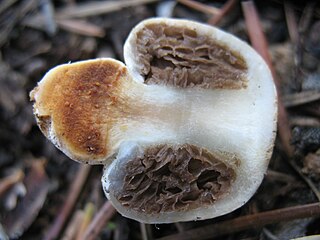Related Research Articles

Lycoperdon is a genus of puffball mushrooms. The genus has a widespread distribution and contains about 50 species. In general, it contains the smaller species such as the pear-shaped puffball and the gem-studded puffball. It was formerly classified within the now-obsolete order Lycoperdales, as the type genus which, following a restructuring of fungal taxonomy brought about by molecular phylogeny, has been split. Lycoperdon is now placed in the family Agaricaceae of the order Agaricales.

The Agaricaceae are a family of basidiomycete fungi and include the genus Agaricus, as well as basidiomycetes previously classified in the families Tulostomataceae, Lepiotaceae, and Lycoperdaceae.

The Psathyrellaceae are a family of dark-spored agarics that generally have rather soft, fragile fruiting bodies, and are characterized by black, dark brown, rarely reddish, or even pastel-colored spore prints. About 50% of species produce fruiting bodies that dissolve into ink-like ooze when the spores are mature via autodigestion. Prior to phylogenetic research based upon DNA comparisons, most of the species that autodigested were classified as Coprinaceae, which contained all of the inky-cap mushrooms. However, the type species of Coprinus, Coprinus comatus, and a few other species, were found to be more closely related to Agaricaceae. The former genus Coprinus was split between two families, and the name "Coprinaceae" became a synonym of Agaricaceae in its 21st-century phylogenetic redefinition. Note that in the 19th and early 20th centuries the family name Agaricaceae had far broader application, while in the late 20th century it had a narrower application. The family name Psathyrellaceae is based on the former Coprinaceae subfamily name Psathyrelloideae. The type genus Psathyrella consists of species that produce fruiting bodies which do not liquify via autodigestion. Psathyrella remained a polyphyletic genus until it was split into several genera including 3 new ones in 2015. Lacrymaria is another genus that does not autodigest its fruiting bodies. It is characterized by rough basidiospores and lamellar edges that exude beads of clear liquid when in prime condition, hence the Latin reference, lacryma (tears).

Cuphophyllus is a genus of agaric fungi in the family Hygrophoraceae. Cuphophyllus species belong to a group known as waxcaps in English, sometimes also waxy caps in North America or waxgills in New Zealand. In Europe, Cuphophyllus species are typical of waxcap grasslands, a declining habitat due to changing agricultural practices. As a result, four species, Cuphophyllus atlanticus, C. colemannianus, C. lacmus, and C. lepidopus are of global conservation concern and are listed as "vulnerable" on the IUCN Red List of Threatened Species.
Gigasperma is an inactive genus of fungi in the order Agaricales with a single species. It was treated either as the only genus in the monotypic family Gigaspermataceae, or part of the wider Cortinariaceae. Gigasperma was circumscribed by Austrian mycologist Egon Horak in 1971.

Cystodermella is a genus of fungi in the family Agaricaceae. The genus comprises about 12 species, noted for producing agaric fruit bodies, bearing a cap, white gills and stipe with a fine, ephemeral ring. The genus was devised by Harri Harmaja in 2002, dividing the older genus Cystoderma into three independent genera: Cystoderma, Ripartitella and Cystodermella largely on the basis of microscopic differences. Cystodermella species bear non-amyloid spores and sometimes cystidia. The spores, in contrast to Ripartitella are not echinulate.
Hiatulopsis is a genus of two species of fungi in the family Agaricaceae. The genus was circumscribed in 1967 by mycologists K. Grinling and Rolf Singer with H. amara as the type species. H. aureoflava was added to the genus by Singer in 1989.
Hypogaea is a fungal genus in the family Agaricaceae. It is a monotypic genus, containing the single secotioid species Hypogaea brunnea, described as new to science in 1963 by mycologist Egon Horak.
Lycoperdopsis is a fungal genus in the family Agaricaceae. A monotypic genus, it contains the single gasteroid species Lycoperdopsis arcyrioides, described as new to science in 1900.
Pseudoauricularia is a genus of fungi in the family Agaricaceae. This is a monotypic genus, containing the single species Pseudoauricularia papuana, described as new to science in 1982 by Japanese mycologist Yosio Kobayasi.
Smithiomyces is a genus of fungi in the family Agaricaceae. It was circumscribed by Rolf Singer in 1944. The type species, S. mexicanus, was formerly placed in Amanita, as well as the now obsolete genera Leucomyces and Venenarius. The genus was named to honor American mycologist Alexander H. Smith.
Termiticola is a fungal genus in the family Agaricaceae. It is a monotypic genus, containing the single species Termiticola rubescens, found in Papua New Guinea.

Descolea is a genus of fungi in the family Bolbitiaceae. Described by mycologist Rolf Singer in 1952, the widespread genus contains about 15 species. It was formerly placed in the family Cortinariaceae because of its limoniform basidiospores and its ectomycorrhizal lifestyle. A 2013 molecular phylogenetics study by Tóth et al. found it to be closely related to the genus Pholiotina The genus Pseudodescolea, erected for the single Descolea-like species Pseudodescolea lepiotiformis, was formerly considered distinct until a 1990 study found it to be a synonym of Descolea antarctica.

Nivatogastrium is a genus of secotioid fungi in the family Strophariaceae. The genus has contained four species found in North America and New Zealand, but the type species, Nivatogastrium nubigenum, is now considered to be a gasteroid species of Pholiota, and was transferred to that genus in 2014.
Egon Horak is an Austrian mycologist who has described more than 1000 species of fungi, including many from the Southern Hemisphere, particularly New Zealand and South America. He was an executive editor of the scientific journal Sydowia from 1975 to 1989, and a member of the editorial board afterwards.
References
- ↑ Horak E. (1971). "Contributions to the knowledge of the Agaricales s.l. (Fungi) of New Zealand". New Zealand Journal of Botany. 9 (3): 463–93. Bibcode:1971NZJB....9..463H. doi: 10.1080/0028825X.1971.10430194 .

- ↑ Kirk PM, Cannon PF, Minter DW, Stalpers JA (2008). Dictionary of the Fungi (10th ed.). Wallingford, UK: CAB International. p. 178. ISBN 978-0-85199-826-8.